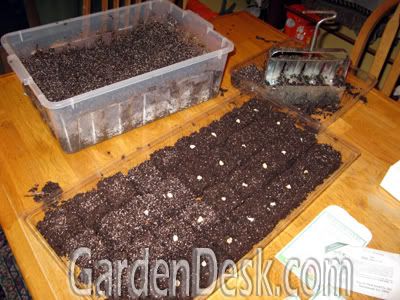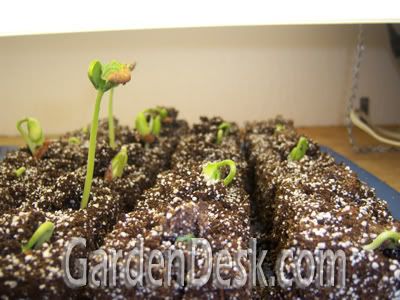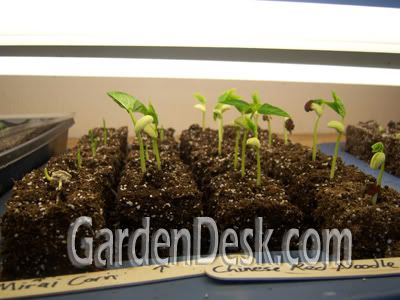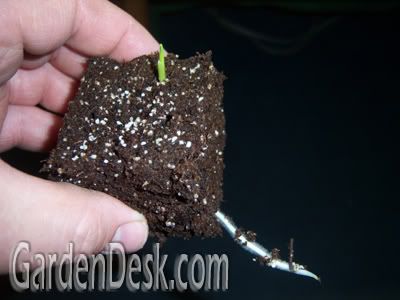Soil Blocks to the Rescue!
We haven't had much rain in the past month so it has been pretty difficult to get new seeds planted out in the garden to germinate. I have had to water the bush bean area everyday to keep the top of the soil from crusting over. On days that I miss, the top layer of the soil dries out and the seeds can't break through. While dealing with this frustration I got to thinking, there has to be a better way.
What about my soil block maker?!

Beans and corn are two vegetables not usually grown indoors and transplanted because they have very delicate roots that don't take well to transplanting. Squeezing the seedlings out of a cell pack or wrestling them out of pots can be harmful to them. With soil blocks the transplant shock should be minimal or nonexistent!
A week or so ago I set out making blocks and planting seeds for my pole beans and my Mirai 301BC corn.

If you don't know what a soil block is, I wrote about them earlier this year. I got mine from Johnny's Selected Seeds. If you want to know more about soil block makers, Johnny's has a great PDF file explaining them better. Also, Jason, who has commented on this blog before, has a whole website devoted to soil blocks. He calls them potting blocks and his site is pottingblocks.com.
What will make soil blocks great for beans and corn is that there are no pots to remove, so the roots won't be disturbed. I can gently place the block in a small hole the garden and cover up around the block with garden soil.
The major difference in dealing with soil blocks under lights is the way you water them. As I have stated before, I am a big fan of bottom watering seedlings under grow lights. With the blocks, you have to spray from above daily to assure that the blocks don't dry out. After the plant roots have taken over the block, you can then lightly pour water into the block.
Here are the pole been seeds popping through the soil block:

Every seed germinated since I have better control over their conditions than if planted directly outside.

Here are the baby corn sprouts poking through on their first day:

What makes corn so difficult to grow indoors is that the taproots grow very quickly. Look at it sticking out of the soil block on day two after germinating!

These corn plants are already outside hardening off and will go into the garden very soon. The key is to transplant them only about a week after they sprout inside in the soil block.
So there you have it - soil blocks to the rescue with guaranteed germination. This morning the McCaslan pole beans were transplanted into the garden and the corn and other pole beans are waiting for tonight. Living in Kentucky, I have to grow Kentucky Wonder Pole Beans of course. My third pole bean variety is the crazy Chinese Red Noodle Bean that grows 18" pods! More on that later....














5 comments:
I can't believe how quickly they take off. I suppose when you have perfect conditions, it makes all the difference. I wonder if I could pull off a similar technique for the bare lawn spots I have left from putting in a pation last year. Thanks for the idea.
Is it weird that the soil blocks made me hungry? - they look like delicious brownies.
We're the opposite here..so much rain I'm wondering if my bush beans washed away.
This is a good idea, I would imagine peat pots would work as well too.
Your tomatoes are looking very good, mine are about 9" high at the moment so I am a little envious. I am planing on start mine a lot earlier next year as well as do the plastic tenting so I can plant them out earlier.
You have a wonderful blog, I will have to keep checking in.
__________________________________
Check out my veggie garden blog:
http://veggiegardenblog.blogspot.com/
Excellent again! Soil blocks for beans and corn are the only way to go for me. Old timers can't understand this transplant concept. Although, there corn and beans haven't come up yet, and due to the cool, cloudy, wet weather, may be rotting in the ground. Not with soil blocks! They will sit there very firmly waiting for warmth and sunshine. The blocks protect them from invaders and they look very healthy. I'll be the first one with sweet corn in all of Oregon because I use early maturing varieties started in early May in soil blocks. Transplanting them is easy if you seperate the blocks a bit and keep the taproot watered well! More at www.pottingblocks.com
Try reading my blog.
Post a Comment